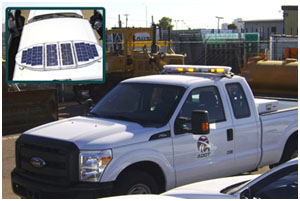Background
When crews are working at the side of the road, the emergency flashing lights atop their trucks are crucial to the workers’ safety and to the protection of passing motorists. But DOT trucks must keep their engines idling to maintain power for the safety lights, without which the vehicle’s battery would quickly be drained.
According to research published by the Transportation Research Board, overnight and workday idling of commercial trucks consumes well over 2 billion gallons of fuel (mostly diesel) yearly in the United States. A study by the Arizona Department of Transportation (ADOT) showed that its trucks typically idle 60 percent of the time they are in use, primarily to provide power for emergency lights.
To save fuel and cut the amount of air pollutants emitted by maintenance vehicles, ADOT is pilot-testing a solar powered version of its traditional emergency lighting system for pickup trucks that takes advantage of Arizona’s plentiful sunshine. The pilot tests will verify the durability and performance of the lighting system under different climate conditions around the state. In 2011, the first group of ADOT vehicles was equipped with the first generation of solar light bars. In 2012, second generation light bars were installed on additional vehicles. In both versions of the lighting systems, the sun’s energy is stored in lithium-ion battery packs. As a side benefit, the new system also takes less time to install versus the traditional hard-wired emergency lighting arrangements due to its wireless operation.
With independently powered solar lights, crews can pull off the highway and run the emergency lights with the engine turned off. By doing so, emissions are reduced while drivers still are safely alerted to the maintenance workers along the highway.

A view of emergency vehicle lighting and solar panel (inset). Photo: Arizona DOT
Idle Time Cut Significantly
Results from the ADOT pilot indicate that the solar equipment has significantly cut the idle time of its vehicles. It is expected that the use of solar lights on a single light duty pickup truck could save hundreds of gallons of diesel fuel a year. ADOT staff estimates that the new lighting should pay for itself in the first 15-19 months of operation, depending upon the actual vehicle use and fuel costs.
To date, ADOT has installed programmable solar powered light bars on approximately 100 trucks out of a fleet of 4,300 vehicles, according to ADOT spokesman Tim Tait. The department has plans to incorporate improvements such as enhanced battery pack performance designed with a higher heat tolerance, improved wireless controllers with more power-level indicators, and additional lighting modules.
A view of emergency vehicle lighting and solar panel (inset). Photo: Arizona DOT
ADOT continues to test and evaluate these lighting systems, Tait said.
“Having emergency lights that can operate without an engine running saves all of us money on vehicle maintenance. It reduces wasted fuel and helps the environment while still meeting the safety needs of ADOT workers,” said John Nichols, ADOT Director of Administrative Services
More information is available from ADOT by contacting Tim Tait at (602) 712-7070, [email protected].